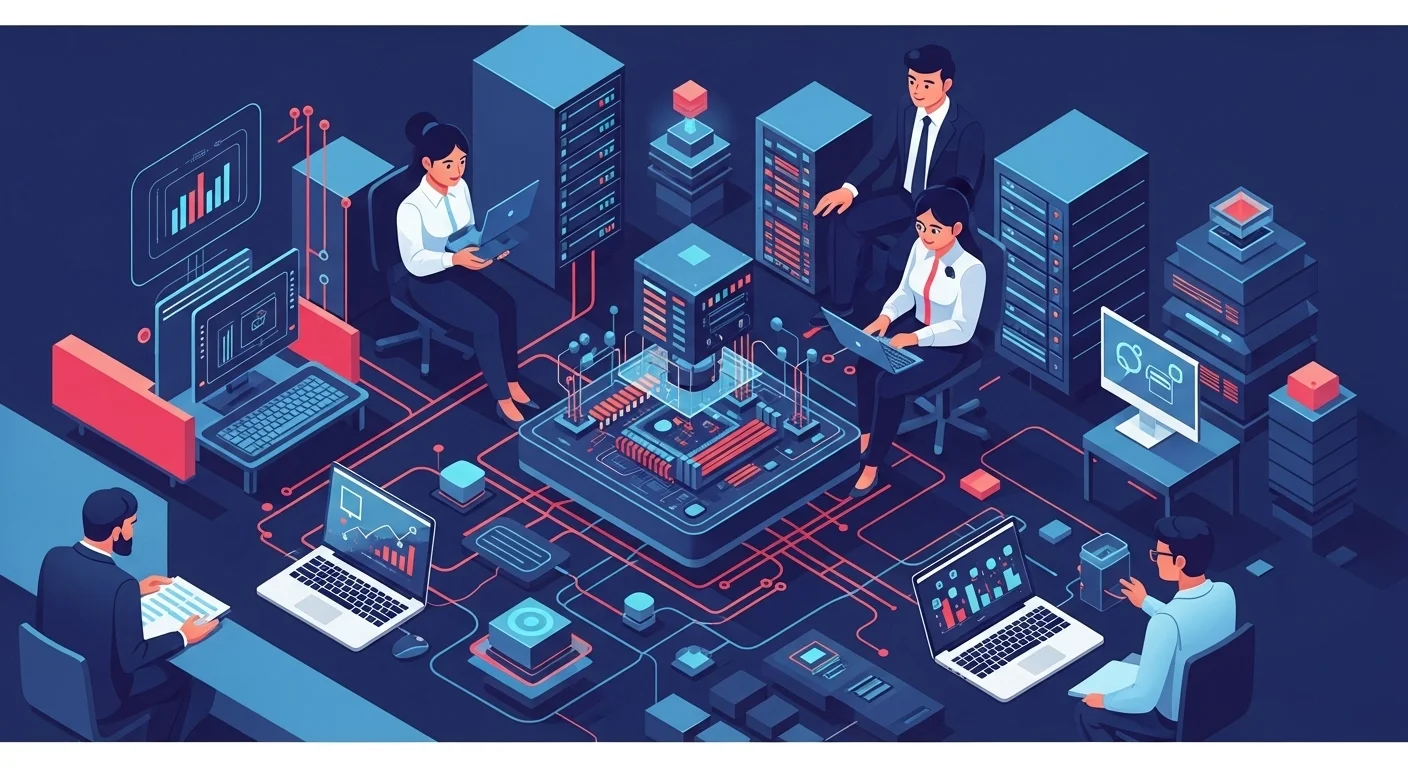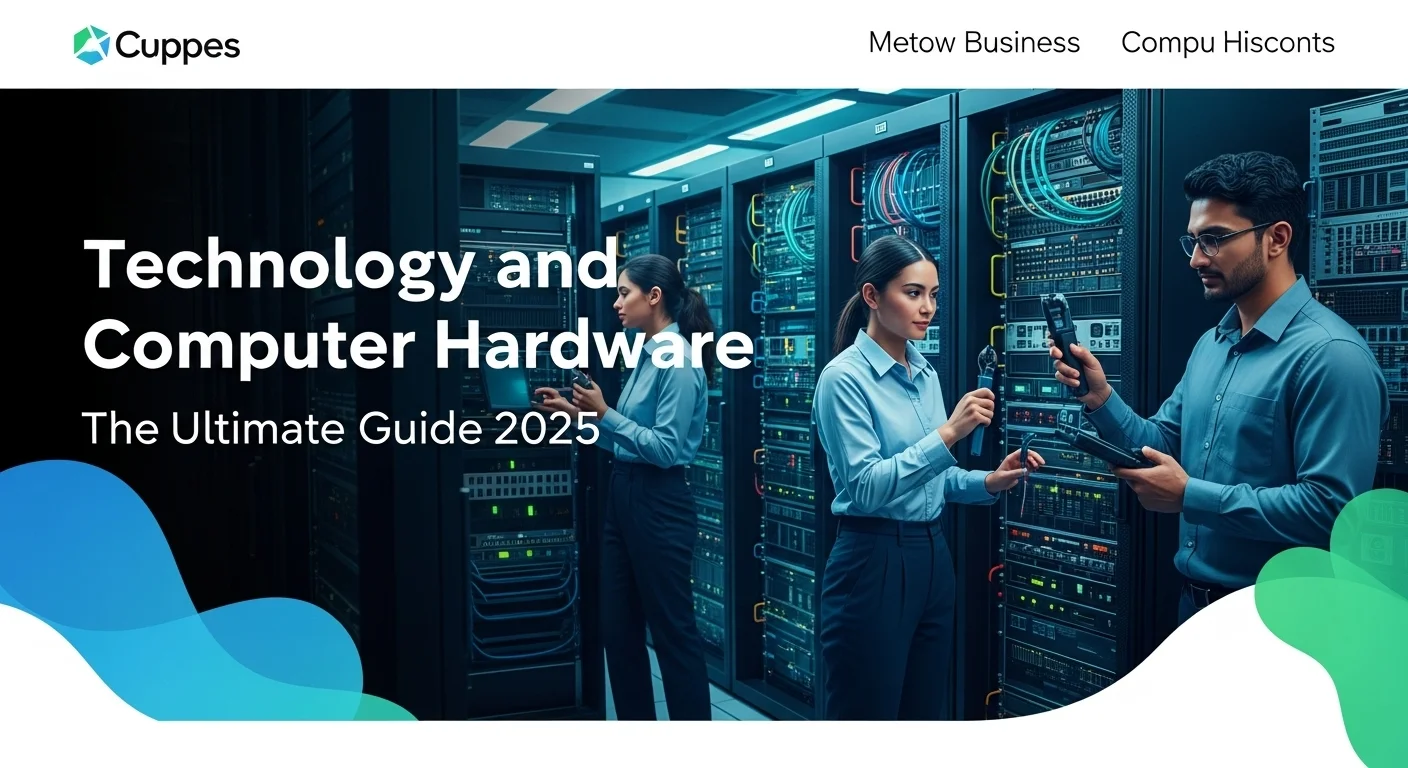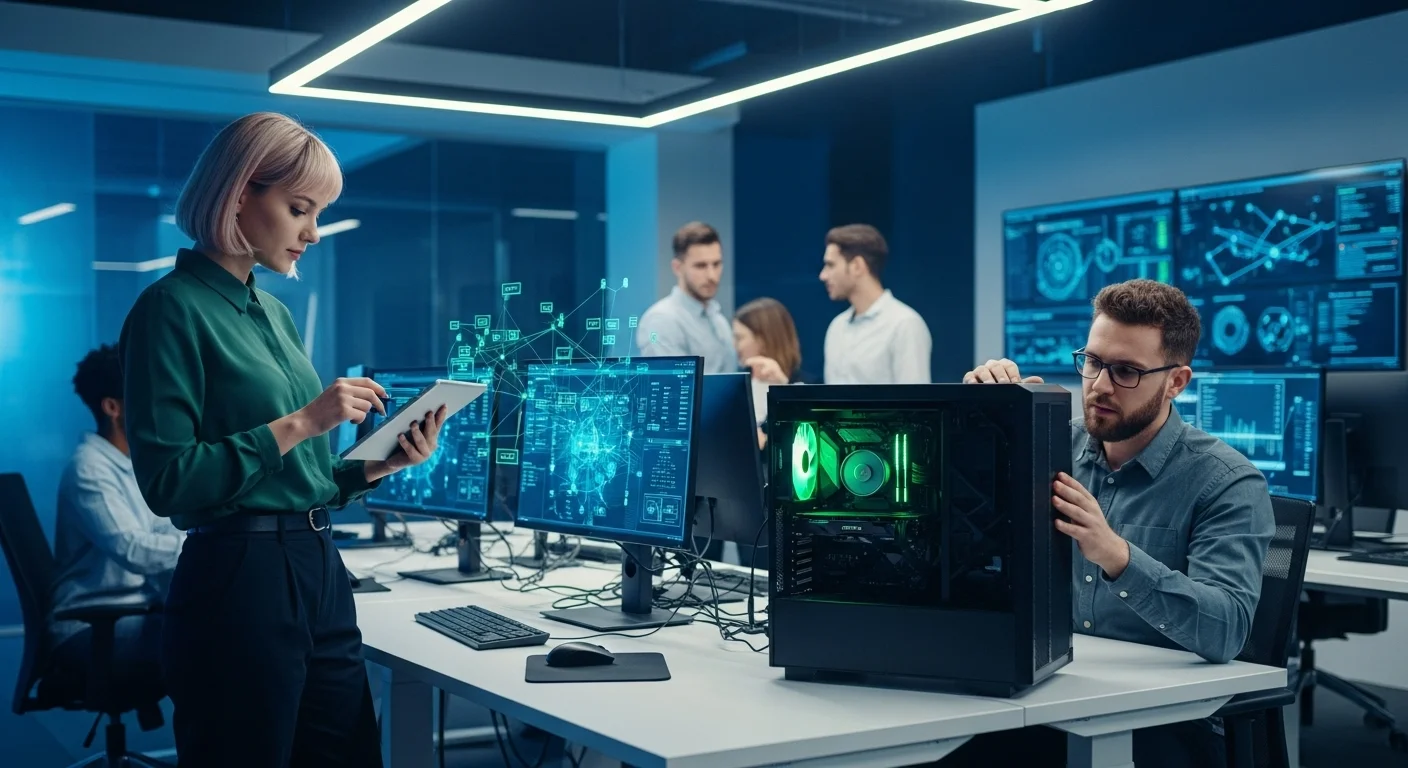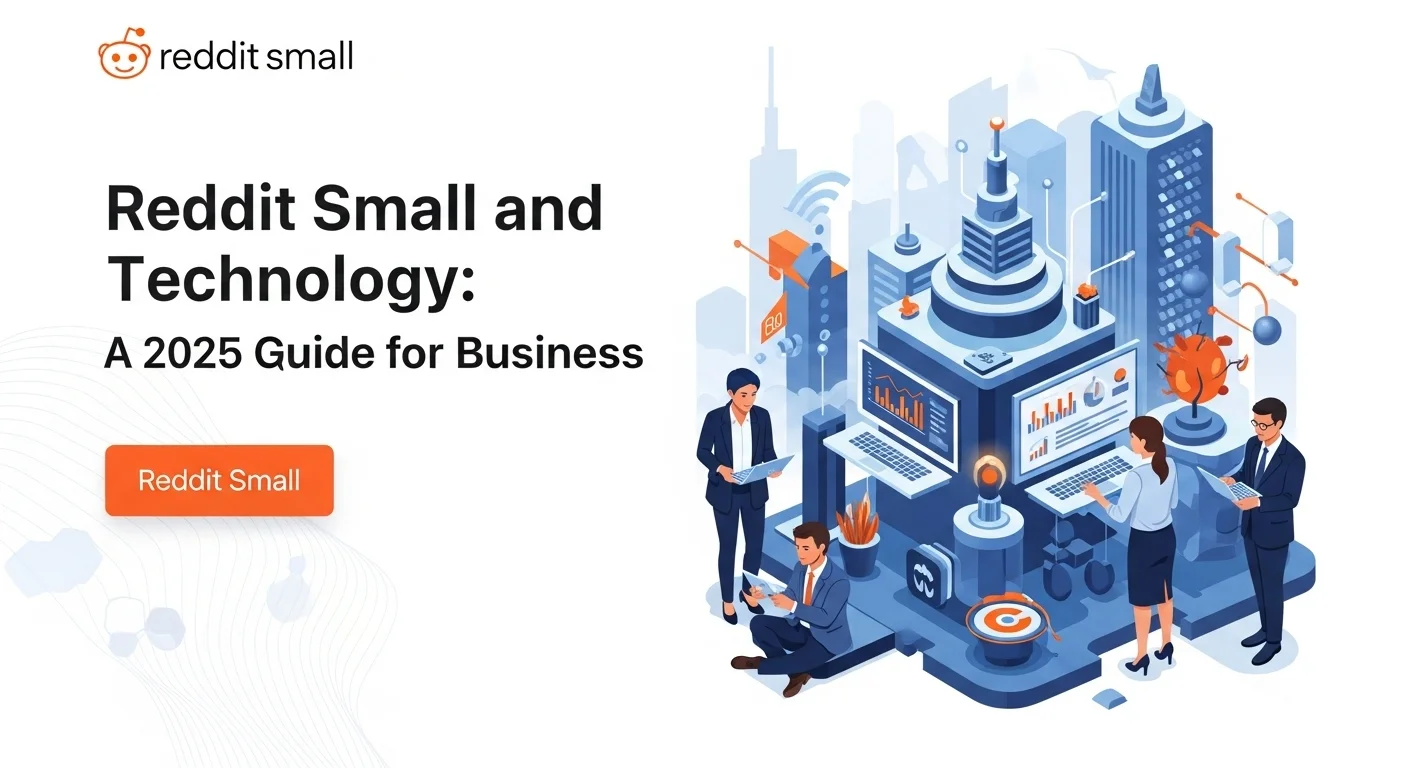Your Ultimate Guide to Computer Hardware: From PCs to the Cloud

Executive Summary
In our hyper-digital world, it's easy to get lost in the magic of software, apps, and the internet. But what about the physical stuff that makes it all possible? I’ve been fascinated by computer hardware since I built my first PC as a teenager, carefully piecing together the motherboard, CPU, and RAM. That experience taught me a vital lesson: understanding the hardware is like knowing what’s under the hood of your car. It empowers you. This guide is born from that passion. We'll explore the tangible components that form the foundation of our digital lives, from the processor in your laptop to the massive servers powering the cloud. We'll look at the crucial dance between hardware and software and celebrate the engineers who design these marvels. Whether you're a business owner making a critical investment or a tech enthusiast wanting to go deeper, this guide will demystify the hardware that drives digital innovation, helping you understand how solid metal and silicon create pure magic.
Table of Contents
Table of Contents
- What is Computer Hardware and Why is it Important?
- The Unseen Engine of Progress
- Core Components: The Building Blocks of a Computer
- The Role of the Computer Hardware Engineer
- The Dance Between Hardware and Software
- The Shift to the Cloud: A New Frontier
- A Practical Guide to Hardware for Business
- Choosing the Right Hardware: A Strategic Decision
- The Hardware Engineer's Impact on Business
- On-Premise vs. Cloud: A Fundamental Choice
- Hardware as a Service (HaaS): The Cloud Model for Your Office
- The Co-evolution of Hardware and Software in Business
- Tips and Strategies for a Better Tech Experience
- Best Practices for Hardware Maintenance
- Business Strategies for Hardware Lifecycle Management
- The Future of Computer Hardware: What's Next?
What is Computer Hardware and why is it important in Technology?
At its heart, computer hardware is everything you can physically touch in a computer system. Think of it as the body of a digital being. It's the sturdy case, the intricate motherboard, the whirring fans, and the glowing lights. It includes the brain—the central processing unit (CPU)—the short-term memory (RAM), the long-term storage (your hard drive or SSD), and all the peripherals like your keyboard, mouse, and monitor that let you interact with it. Software might be the thoughts and instructions, but hardware is the physical machine that brings those instructions to life. They are two sides of the same coin; one is useless without the other. This simple partnership is the engine behind every digital experience you've ever had.
The Unseen Engine of Progress and Business
It's impossible to overstate the importance of hardware. It's the silent, powerful foundation of all digital innovation. The stunning graphics in a video game, the life-saving accuracy of medical scanners, and the complex algorithms that predict market trends all depend on powerful, high-quality hardware. For any business, choosing the right hardware isn't just an IT chore; it's a core strategic decision. Good hardware makes your team more productive, keeps your data secure, and makes your operations run smoothly. Imagine your company's server as the heart of your business, pumping data to where it needs to go. If that heart is weak or old, the whole system suffers. Outdated hardware leads to slowdowns, security holes, and frustrating downtime, all of which hit your bottom line. The relentless march of hardware getting faster and smaller—famously described by Moore's Law—is what has allowed technology to advance at such a breakneck pace, fueling everything from artificial intelligence to the smart devices in our homes.
Core Components: The Building Blocks of a Computer
To really get hardware, you need to know the key players on the team. Each one has a specific and crucial job.
- Central Processing Unit (CPU): This is the 'brain.' It does all the heavy lifting, executing commands and making the calculations that run your programs. The faster the CPU, the snappier your computer feels.
- Random-Access Memory (RAM): Think of RAM as your computer's countertop or workspace. It holds all the data the CPU needs to access right now. More RAM means you can juggle more tasks at once without getting bogged down.
- Storage (HDD & SSD): This is the computer's filing cabinet—its long-term memory. It's where your operating system, software, and files live. Older Hard Disk Drives (HDDs) use spinning disks, while modern Solid-State Drives (SSDs) are like giant flash drives, offering a huge speed boost.
- Motherboard: This is the central nervous system. It's the main circuit board that everything plugs into, allowing all the components to talk to each other.
- Graphics Processing Unit (GPU): Originally for rendering images and video, the GPU has become a powerhouse for more than just gaming. It's a specialized processor that's amazing at handling many tasks at once, making it essential for AI, video editing, and scientific research.
- Power Supply Unit (PSU): The PSU is the unsung hero. It takes power from your wall outlet and converts it into the precise voltages your delicate components need to run safely.
The Indispensable Role of the Computer Hardware Engineer
Behind every breakthrough piece of hardware is a brilliant computer hardware engineer. These are the architects and artists of the physical tech world. They research, design, and test everything from microscopic processors to entire computer systems. A hardware engineer works with circuit boards, materials, and complex computer-aided design (CAD) software to bring new ideas to life. But they don't work in a vacuum. They are in constant collaboration with software engineers to ensure the machine they're building will work perfectly with the code it's meant to run. This teamwork is what makes the magic happen. As we venture into new territories like quantum computing, the skills of a hardware engineer are more critical than ever, pushing the very limits of what we believe is possible.
The Symbiotic Dance: Computer Hardware and Software
The relationship between hardware and software is a beautiful, symbiotic dance. Hardware provides the raw muscle, but it's just a lump of inactive silicon without software to tell it what to do. Software, on the other hand, is limited by the hardware it runs on. A visually stunning new game is worthless if your computer's graphics card can't handle it. This interdependence fuels a constant cycle of innovation. Hardware gets more powerful, allowing software developers to create more amazing and complex applications. This new software then creates a demand for even better hardware, and the dance continues. We saw this with AI and machine learning—their recent explosion was only possible because GPUs became powerful enough to handle the workload. The operating system (like Windows or macOS) acts as the choreographer for this dance, managing the hardware resources so all the software can run smoothly on stage.
The Shift to the Cloud: New Frontiers for Hardware
These days, 'hardware' doesn't just mean the box on your desk. The rise of cloud computing has shifted our focus to the colossal hardware infrastructure humming away in massive data centers. This is cloud computing hardware: endless racks of powerful servers, vast storage systems, and lightning-fast networking gear. This is the physical backbone of services like Netflix, Spotify, and Google Drive. For businesses, this has been a revolution. Instead of buying and maintaining their own expensive servers, they can now rent computing power from a cloud provider. This approach offers incredible flexibility and cost savings. It has also given rise to a model called Hardware as a Service (HaaS). Just like you subscribe to software, you can now 'subscribe' to hardware. A provider gives you the equipment and handles all the maintenance, upgrades, and support for a monthly fee. This model makes cutting-edge technology accessible to even small businesses, turning a huge upfront cost into a manageable operational expense.

Complete guide to Computer Hardware in Technology and Business Solutions
In today's business world, technology isn't just a tool; it's woven into the very fabric of your strategy and success. And the heart of that technology is its hardware. Making smart hardware decisions is absolutely critical for staying competitive. This guide will walk you through how to think about hardware not as an expense, but as a powerful business solution.
Choosing the Right Hardware: A Strategic Business Decision
Picking the right hardware for your company is about so much more than just buying the fastest new computers. It's a strategic analysis of what your business truly needs to thrive. Here's what I always tell my clients to consider:
- Workloads and People: The hardware a graphic designer needs for heavy video rendering is completely different from what a sales team needs for their CRM and email. You have to start by understanding the real-world tasks your employees perform every day.
- Performance and Productivity: Time is money. A slow processor, not enough RAM, or an old-school hard drive can cause small delays that add up to huge productivity losses across your team. Investing in snappy hardware is an investment in your team's efficiency.
- Growth and Future-Proofing: Think 3-5 years down the road. Will you need to add more staff? Will your data needs grow? Choose hardware that can scale with you, whether that means desktops that are easy to upgrade or network switches that can handle more devices. This foresight saves you from expensive, disruptive overhauls later.
- Security from the Ground Up: Modern hardware has security features built right into the silicon, like fingerprint readers, secure boot processes, and chip-level encryption. Making this a priority is a fundamental step in protecting your company's and your customers' precious data secure.
- Total Cost of Ownership (TCO): Don't be fooled by the sticker price. The true cost of hardware includes energy bills, maintenance, software licenses, and the potential cost of downtime. Often, a slightly more expensive business-grade laptop will have a lower TCO over its lifetime than a cheaper consumer model because it's more reliable and built to last.
The Role of the Computer Hardware Engineer in Business Solutions
While your business probably won't hire a computer hardware engineer to pick out laptops, understanding their mindset gives you a powerful advantage. These are the people who design the enterprise-grade servers, reliable workstations, and robust network gear that businesses depend on. They are obsessed with reliability, efficiency, and seamless integration—the very things you should look for. For specialized industries like manufacturing or medicine, a hardware engineer might even be involved in designing custom equipment. Their core principles—rigorous testing, planning for the entire product lifecycle, and ensuring hardware and software work in harmony—are best practices that any smart IT department should adopt.
On-Premise vs. Cloud: A Fundamental Hardware Dilemma
One of the biggest decisions a modern business has to make is where its hardware lives. Do you keep it in-house (on-premise) or move it to the cloud? It's a choice that fundamentally changes how you manage your technology.
On-Premise Hardware
This is the classic model: you buy, house, and maintain your own servers and equipment in your office.Pros:
- Total Control: You own it, you control it. You set the rules for configuration and security.
- Peak Performance: For applications where every millisecond counts, having the hardware right there can offer the fastest speeds.
- Compliance Certainty: For industries with strict rules about where data can be stored, on-premise can make compliance easier to prove.
- Huge Upfront Cost: You have to shell out a lot of capital to buy the equipment.
- Maintenance Headaches: You're on the hook for everything—repairs, security updates, and replacements.
- Tough to Scale: Need more power? You have to go through the slow and expensive process of buying and installing new gear.
Hardware in Cloud Computing
Here, you rent resources from a provider like Amazon Web Services or Microsoft Azure. The physical cloud computing hardware is in their massive data centers.Pros:
- Low Upfront Cost: You trade a large capital expense for a predictable monthly operating bill.
- Incredible Scalability: Need more server power for a big sale? You can get it in minutes. Quiet month? Scale it back down.
- No More Maintenance: The cloud provider handles all the hardware upkeep, security, and upgrades.
- Ongoing Costs: That monthly bill can grow and become complex to track if you're not careful.
- Less Direct Control: You don't get to choose the specific brand of server or storage your data sits on.
- Provider Dependency: You're relying on your provider's uptime and security. If they have a problem, you have a problem.
Hardware as a Service (HaaS): The Cloud Model for Physical Devices
The 'pay-as-you-go' logic of the cloud is so compelling that it's now being applied to the physical devices in your office. This is Hardware as a Service (HaaS). Think of it like leasing a fleet of cars instead of buying them. You pay a monthly fee to a provider for your laptops, desktops, and printers. That provider owns the equipment and handles all the installation, support, maintenance, and—most importantly—replaces it with new gear on a regular schedule. This is a game-changer for a few reasons:
- Predictable Budgeting: Hardware costs become a simple, fixed monthly line item. No more surprise replacement expenses.
- Always Modern Tech: Your employees will never be stuck with slow, outdated machines because refresh cycles are built into the contract.
- Tighter Security: Old hardware is a security risk because it often stops receiving security updates. HaaS ensures your equipment is always current and patched.
- Frees Up Your IT Team: Instead of setting up laptops and fixing printers, your IT staff can focus on bigger, more strategic projects.
The Co-evolution of Computer Hardware and Software in Business
You can never think about hardware without thinking about software. The two are in a constant state of co-evolution that drives business technology forward. When you choose hardware, you have to be 100% sure it works with your core business software. But it goes deeper than that. The demand for new software capabilities, like AI, forces the creation of new kinds of hardware. For example, the need for AI processing led to specialized cloud computing hardware like Google's Tensor Processing Units (TPUs), custom chips designed for one job. This shows the cycle: software creates a need, and hardware engineering rises to meet it. For a business, this means your software strategy and your hardware strategy must be in sync. Understanding this powerful relationship is key to making smart technology choices that will keep you ahead of the curve.

Tips and strategies for Computer Hardware to improve your Technology experience
Whether you're managing hundreds of devices for your business or just want your home PC to run at its best, a little proactive care for your hardware goes a long way. Smart maintenance, strategic upgrades, and an eye on the future can make your tech last longer, run safer, and give you more bang for your buck. Here are some practical tips and strategies I've learned over the years.
Best Practices for Hardware Maintenance and Longevity
Good physical maintenance is the cheapest and easiest way to protect your hardware investment. It’s amazing how many performance problems and failures I've seen that could have been prevented with a little care.
- Declare War on Dust: Dust is the silent killer of electronics. It acts like a blanket, trapping heat and forcing your fans to work overtime until they fail. At least a couple of times a year, open up your desktop case and use cans of compressed air to gently blow the dust out of fans, vents, and heat sinks. A clean machine is a happy machine.
- Let it Breathe: Your computer needs good airflow to stay cool. Make sure the vents on your laptop or desktop aren't blocked by books, walls, or blankets. If you have a server room, proper cooling isn't a luxury; it's essential to prevent component damage.
- Tame the Cable Monster: A tangled mess of cables behind your desk isn't just ugly; it can block airflow and create a hazard. If someone trips on a cord, they could yank it right out and damage the port. Use some simple cable ties or sleeves to keep things organized.
- Defend Against Power Spikes: A power surge from a lightning storm or grid issue can fry your sensitive electronics in an instant. Every computer should be plugged into a quality surge protector. For critical machines like your main work computer or a server, an Uninterruptible Power Supply (UPS) is a must. It provides a battery backup that gives you time to save your work and shut down safely during a blackout.
- Keep Your Drivers Updated: The connection between your hardware and software is managed by small programs called drivers. Manufacturers regularly release updates that can improve performance, fix bugs, and, most importantly, patch security holes. Keeping your drivers and firmware up-to-date is a simple but critical security step.
Business Strategies for Hardware Lifecycle Management
For a business, managing hardware is a continuous process that covers the entire life of the equipment. Here's how to do it strategically.
- Create a Refresh Policy: Don't wait until computers are painfully slow to replace them. Set a standard refresh cycle, like every 3-4 years for laptops. This keeps your team productive, reduces security risks from old hardware, and makes your budget predictable.
- Standardize Your Fleet: When possible, buy the same models of laptops, desktops, and monitors for your team. This makes life so much easier for your IT support. They only have to learn how to support one type of machine, and you can buy spare parts and accessories in bulk.
- Track Your Assets: Keep a simple inventory of all your hardware. Know what you have, who is using it, when it was bought, and when its warranty expires. This is vital for planning, insurance, and managing your refresh cycle.
- Think in 'As-a-Service' Terms: Even if you buy your hardware outright, adopting the mindset of Hardware as a Service (HaaS) can be powerful. It forces you to think about the total cost, including support and eventual replacement. For many, a true HaaS model is the best way to offload the headache of lifecycle management entirely.
- Plan for a Secure Retirement: When a computer reaches the end of its life, you can't just toss it in the bin. The hard drive contains sensitive company data. You must have a policy for securely wiping the drives or having them physically destroyed by a professional service. This is a non-negotiable final step.
The Future of Computer Hardware: What's Next?
The world of hardware is always moving, and it's an exciting time. The work that computer hardware engineers are doing today sounds like science fiction, but it will be the reality of tomorrow. Here's a glimpse of what's on the horizon:
- AI-Specific Hardware: The massive demand for AI is leading to a new wave of specialized processors. We're moving beyond GPUs to custom-built chips designed to do one thing incredibly well: run AI models. This is especially true for cloud computing hardware, where giants like Google and Amazon are designing their own chips to power their AI services.
- Quantum Computing: This is the big one. While it's still early days, quantum computers work in a fundamentally different way from regular computers, allowing them to solve problems that would take a traditional supercomputer billions of years. This could revolutionize medicine, materials science, and finance.
- Neuromorphic Computing: What if we built a chip that works like a human brain? That's the idea behind neuromorphic computing. These chips are designed to be incredibly energy-efficient and are perfect for recognizing patterns, making them ideal for the next generation of robots and smart devices.
- Green Computing: All this computing power uses a lot of electricity. There's a growing movement to make hardware more sustainable and energy-efficient. This is a huge focus for the massive data centers that power the cloud, and it's becoming a key consideration for all hardware design.
- Edge Computing: Instead of sending all data to the cloud, edge computing does the processing right where the data is created—on a smart camera, in a self-driving car, or on a factory floor. This requires a new class of powerful, durable, and compact hardware that can operate in the real world.
Expert Reviews & Testimonials
Sarah Johnson, Business Owner ⭐⭐⭐⭐
As a small business owner, I always found hardware decisions daunting. This guide broke down the difference between on-premise and cloud in a way I finally understood. The section on HaaS was a game-changer for my budget planning. A few more case studies would be the cherry on top.
Mike Chen, IT Consultant ⭐⭐⭐⭐⭐
As an IT consultant, I'm often asked to explain these concepts to clients. This article is a great resource. It avoids overly technical jargon and uses relatable analogies. I'll be sharing this with my clients to help them grasp why a hardware refresh is more than just an expense—it's an investment.
Emma Davis, Tech Expert ⭐⭐⭐⭐⭐
I've been building PCs for years, and even I learned something new here! The look into the future of hardware, especially neuromorphic and quantum computing, was fascinating and well-explained. It’s a comprehensive piece that connects the dots from the desktop enthusiast to the future of the entire industry. Excellent work!



